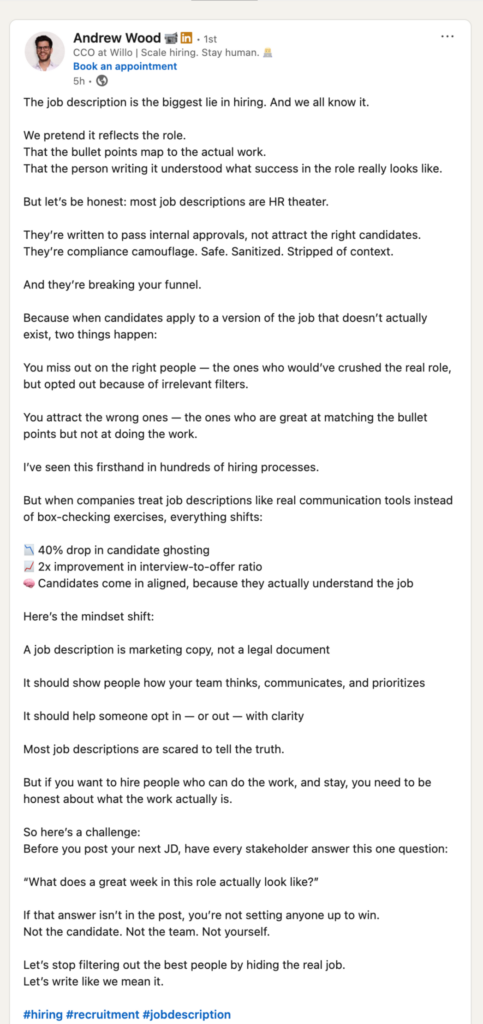- 16 Helpful Career Site Self-Service Tools for You - December 18, 2025
- Last Week I Had a Viral LinkedIn Post — But Why? (And What TA Folks Can Learn From It) - December 8, 2025
- Job Description Process Improvement: How One Workflow Fix Saved 1,200 JDs from Chaos - December 4, 2025
Every time I read a job description, I play a little game. It’s called: “What’s actually true here?” Spoiler alert: I usually lose.
That’s why Andrew Wood’s LinkedIn post hit home. He called job descriptions the “biggest lie in hiring.” And yep, I’m nodding along. Here’s his full post:

We’ve all seen it. Bullet points that read like they were Frankensteined together by three different people who never met. A requirements list longer than your holiday shopping list. And vague statements like “fast-paced environment” that could mean anything from mild chaos to full-on fire drill.
Let’s Stop Pretending…Most Job Descriptions are Bad!
Here’s the truth: Most bad job descriptions aren’t written to attract people. They’re written to pass approvals. Legal wants their stuff. HR wants compliance. Hiring managers want to copy/paste the last one. And somewhere along the way, the real job—the stuff someone will actually do every day—gets lost.
And that’s dangerous. Because when we dress up roles to look like something they’re not, we break the hiring funnel. We scare off great people who would’ve been perfect. And we pull in folks who can recite our JD back to us but can’t do the work.
I’ve seen this firsthand, helping companies write job descriptions that actually work. One team I worked with ditched their 2-page JD template and replaced it with one question: “What does a great week in this job look like?” They still involve all of the people that matter in the process, but there is a new process for writing job postings, and they use Text Analyzer to keep it automated!
The results? They doubled their interview-to-offer ratio and cut candidate ghosting nearly in half. Why? Because the job finally made sense to the person reading it.
If you’re curious what writing a good job description actually looks like, check out our guide on how to write a job description. It breaks down best practices in a practical way. Or scroll through these great examples to see how real companies are getting it right.
The JD Isn’t a Legal Doc. It’s a Billboard.
Andrew put it best (and I say this daily in our demo calls):
“A job description is marketing copy, not a legal document.”
That’s the mindset shift we all need. Think of your JD like a dating profile for your team. Be honest. Be specific. Show your quirks. Tell folks what it’s really like on a Tuesday afternoon.
Instead of listing 19 responsibilities, talk about what success looks like. Instead of vague values like “collaboration,” describe how your team actually works together. Use plain language. Avoid jargon. And, tell the truth.
One of my favorite JDs ever was for a product manager role. It started with: “This job is messy. You’ll need to manage vague requests, get buy-in from a few teams who disagree, and ship anyway. If that sounds like fun, keep reading.”
Job postings like these get more qualified applicants than any other postings. They are real.
Real Role, Real Results
When companies fix bad job descriptions and treat them like communication tools (not just checklists), everything changes:
- Less ghosting: Candidates know what they’re signing up for.
- Better interviews: People come prepared with context.
- More retention: New hires aren’t shocked by reality.
The JD becomes a filter, not to weed people out, but to help them self-select in (or out) based on what matters. That’s a win for everyone.
Try This Before You Post Bad Job Descriptions
So before you hit “publish” on your next JD, stop. Grab every person, hiring manager, team lead, maybe even the person currently in the role, and ask:
“What does a great week in this role actually look like?”
If your job description doesn’t answer that, you’re not setting anyone up to win. Not the candidate. Not the team. Not yourself.
If you want to see how a real pro writes job descriptions, watch this webinar we did with Kat Kibben from Three Ears Media.
In this hour-long session, Kat shares tips on ditching corporate buzzwords, using AI effectively, and sharpening your message so it speaks directly to your ideal candidate.
With 15+ years of experience and insights featured in The New York Times and Forbes, Kat brings the clarity and candor most hiring teams wish they had when writing job descriptions.
Why I Wrote This
At Ongig, we help companies fix bad job descriptions and create ones that tell the truth and get results. If you’re tired of HR theater and want your job posts to actually attract the right people, request a demo. We’ll show you how to turn your JDs into your best recruiting tool.
FAQs
Why do most job descriptions fall short?
Because they’re written for internal approvals, not for real people. That’s why they feel stiff and generic.
How can I make my job descriptions more effective?
Start by writing like a human. Focus on what success looks like, not just what tasks exist. Be clear, specific, and honest.
What’s the benefit of honest JDs?
You attract better fits, reduce ghosting, and set expectations that lead to stronger interviews and better hires.
What tools can help?
Ongig’s platform makes it easy to manage and upgrade all your job descriptions, from tone and structure to SEO.
Is pay transparency important?
Yes! Candidates want clarity. Sharing pay ranges builds trust and helps widen your talent pool.
